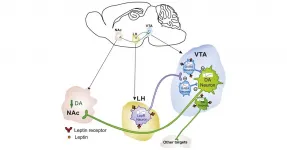(Press-News.org) LAWRENCE -- An international trade law expert at the University of Kansas argues in a pair of new articles that human rights and trade are now inextricably linked, as evidenced by U.S. and international reactions to actions in China, and asserts that approach is an appropriate use of trade.
Raj BhalaAfter the United States, then Canada and the Netherlands, declared the Chinese Communist Party's actions against Uyghur Muslims as genocide, the nations followed with various trade sanctions. Likewise, countries have adopted trade measures in response to China's violation of its one-country, two-systems agreement with Hong Kong. Raj Bhala, Brenneisen Distinguished Professor of Law at the KU School of Law, details both situations in two new companion case studies, argues the linking of trade to human rights is correct and examines future possibilities for such measures.
"Most people think human rights are to be separated from trade. In fact, that's not true," Bhala said. "There are no express, comprehensive provisions for human rights in the World Trade Organization or General Agreement on Tariffs and Trade, but we're seeing the link come up in U.S. trade policy and some regional free trade agreements. We're entering an era of invigorated enhancements of human rights through trade policy."
Bhala wrote an article on China's treatment of Uyghur Muslims and American trade response, published in India's Journal of the National Human Rights Commission, and another on Hong Kong's democracy, China's violation thereof and American trade response, forthcoming in the Kansas Journal of Law & Public Policy.
Former President Donald Trump's disputes with China and resulting trade war were widely debated and criticized. But, Bhala points out the sometimes-overlooked trade reactions to the events in Xinjiang and Hong Kong are distinct, and defensible, actions. While thoroughly detailing the economic and legal actions of each case, he points out how the United States and China are in a new era of great power competition. He also outlines how, historically, trade and human rights were considered separate matters, and he chronicles how and why the earliest connections between the two issues occurred.
"The articles make the point that the two issues, international trade and human rights, are now inextricably linked," Bhala said. "In one situation, we have what three governments have already called genocide, and what the world generally agrees is a violation of China's one-country, two-systems policy in Hong Kong in the other."
The former system involves genocide of a religious minority, while the latter involves legally codified human rights such as direct elections and peaceful assembly in Hong Kong. The United States has taken various trade actions, such as banning imports of Chinese products like cotton and tomatoes from Xinjiang in the first case, and freezing assets of Chinese Communist Party officials on the mainland in the second.
Bhala argues that such sanctions and related actions are appropriate. The World Trade Organization does not provide for trade remedies to human rights violations or crimes against humanity, hence options through that multilateral venue are limited.
"If we don't use trade measures like sanctions in these two egregious instances, then when would we?" Bhala said.
In addition to outlining in the articles the legal responses and arguing they are justified, Bhala examines how the United States and other nations will most likely continue to use such measures in the future. Numerous contexts, including China's actions toward Tibet, Taiwan and across the South China Sea and its self-declared Nine Dash Line, will most likely cause disagreement and conflict between the two world powers. He also emphasizes the conflicts are not with the Chinese people, but with the actions and policies of their government.
"We know the Chinese people are not monolithic in their views of their own government," Bhala said. "There are many people in Hong Kong and on the mainland who are concerned with what has happened in Xinjiang with the Uyghur population, and also in respect to what has happened in Tibet and Taiwan."
While it may be too early to know what the long-term results of trade remedies to human rights violations may be, or whether they will escalate tensions, the ongoing situations are confirmation that international trade and human rights are two sides of the same coin.
"If we've learned nothing else, it's that trade policy is national security policy is human rights policy," Bhala said. "Our national security is based on our values. We express our values partly through who we decide to trade with, and the terms on which we trade with them. Trade is not only about trade."
INFORMATION:
Researchers at the University of Konstanz and Max Planck Institute for Animal Behavior in Germany have found that birds are able to change their culture to become more efficient. Populations of great tits were able to switch from one behavior to a better alternative when their group members were slowly replaced with new birds. Published today as open access in the journal Current Biology, this research reveals immigration as a powerful driver of cultural change in animal groups that could help them to adapt to rapidly changing environments.
In animals, "culture" is considered to be any behavior that is learned from others, shared by members of the ...
Ann Arbor, April 6, 2021 - New data from the Centers for Disease Control and Prevention (CDC) show that one in four adults with HIV in the United States has experienced intimate partner violence (IPV), which disproportionately affects women and LGBT populations. Further, people with HIV who experienced IPV in the past 12 months were more likely to engage in behaviors associated with elevated HIV transmission risk, were less likely to be engaged in routine HIV care and more likely to seek emergency care services and have poor HIV clinical outcomes. The findings are reported in the American Journal of Preventive Medicine, published by Elsevier.
Lead Investigator Ansley B. Lemons-Lyn, MPH, and colleagues from the CDC's National Center for HIV/AIDS, Viral Hepatitis, ...
At a cost of $38 billion a year, an estimated 5.3 million people are living with a permanent disability related to traumatic brain injury in the United States today, according to the Centers for Disease Control and Prevention. The physical, mental and financial toll of a TBI can be enormous, but new research from the University of Georgia provides promise.
In a new study, researchers at UGA's Regenerative Biosciences Center have demonstrated the long-term benefits of a hydrogel, which they call "brain glue," for the treatment of traumatic brain injury. The new study provides evidence that not only does the gel protect against loss of brain tissue after ...
Bethesda, MD (April 6, 2021) -- Obesity is a global pandemic, affecting about 40% of adults in the United States. There is an enormous unmet need for an effective weight-loss solution. After a detailed review of available literature, the American Gastroenterological Association (AGA) has released new clinical guidelines recommending the use of intragastric balloons (IGB) for patients with obesity who have not been able to lose weight with traditional weight-loss strategies. This treatment is most successful with accompanying therapy, such as lifestyle modifications and pharmacological agents, ...
Researchers have uncovered pathways involved in the body's response to glucocorticoid treatments and identified a novel biomarker that could be used to monitor how these drugs work in patients, according to a clinical study published today in eLife.
A more reliable indicator of an individual's response to glucocorticoid drugs could be used to develop a clinically applicable test that could help tailor treatments and potentially minimise side-effects.
Glucocorticoids, such as cortisol, are a type of hormone with key roles in the body's response to stress. Glucocorticoid ...
Researchers from Skoltech and their collaborators have designed, synthesized and evaluated new compounds that can serve as catholytes and anolytes for organic redox flow batteries, bringing this promising technology closer to large-scale implementation. The two papers were published in the END ...
A new U.S. Geological Survey study provides an updated, statewide estimate of high levels of naturally occurring arsenic and uranium in private well water across Connecticut. This research builds on a USGS report published in 2017, with the new study including additional groundwater samples and focusing on previously underrepresented areas.
The research, undertaken in cooperation with the Connecticut Department of Public Health, projects that approximately 3.9% of private wells across Connecticut contain water with arsenic at concentrations higher than the U.S. Environmental Protection Agency's maximum contaminant level for ...
Sea urchins receive a lot of attention in California. Red urchins support a thriving fishery, while their purple cousins are often blamed for mowing down kelp forests to create urchin barrens. Yet for all the notice we pay them, we know surprisingly little about the microbiomes that support these spiny species.
Researchers at UC Santa Barbara led by geneticist Paige Miller sought to uncover the diversity within the guts of these important kelp forest inhabitants. Their results reveal significant differences between the microbiota of the two species, as well as between individuals living ...
Philadelphia, April 6, 2021 - Since the discovery of leptin in the 1990s, researchers have wondered, how does leptin, a hormone made by body fat, suppress appetite? Despite tremendous gains in the intervening three decades, many questions still remain. Now, a new study in mice describes novel neurocircuitry between midbrain structures that control feeding behaviors that are under modulatory control by leptin. The study appears in Biological Psychiatry, published by Elsevier.
John Krystal, MD, Editor of Biological Psychiatry, said of the findings, "Omrani and colleagues shed light on how, in non-obese animals, leptin puts the brakes on overeating."
Leptin acts as a critical link between the body and the brain, providing information about metabolic ...
In addition to smoothing out wrinkles, researchers have found that the drug Botox can reveal the inner workings of the brain. A new study used it to show that feedback from individual nerve cells controls the release of dopamine, a chemical messenger involved in motivation, memory, and movement.
Such "self-regulation," the researchers say, stands in contrast to the widely held view that the release of dopamine -- known as the "feel good" hormone -- by any cell relied on messages from nearby cells to recognize that it is releasing too much of the hormone.
Led by researchers at NYU Grossman School of Medicine, ...


